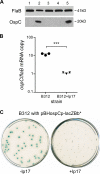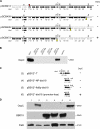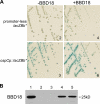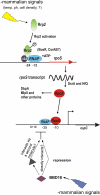Regulation of the virulence determinant OspC by bbd18 on linear plasmid lp17 of Borrelia burgdorferi
- PMID: 21784941
- PMCID: PMC3187453
- DOI: 10.1128/JB.01496-10
Regulation of the virulence determinant OspC by bbd18 on linear plasmid lp17 of Borrelia burgdorferi
Abstract
Persistent infection of a mammalian host by Borrelia burgdorferi, the spirochete that causes Lyme disease, requires specific downregulation of an immunogenic outer surface protein, OspC. Although OspC is an essential virulence factor needed by the spirochete to establish infection in the mammal, it represents a potent target for the host acquired immune response, and constitutive expression of OspC results in spirochete clearance. In this study, we demonstrate that a factor encoded on a linear plasmid of B. burgdorferi, lp17, can negatively regulate ospC transcription from the endogenous gene on the circular plasmid cp26 and from an ospC promoter-lacZ fusion on a shuttle vector. Furthermore, we have identified bbd18 as the gene on lp17 that is responsible for this effect. These data identify a novel component of ospC regulation and provide the basis for determining the molecular mechanisms of ospC repression in vivo.
Figures




Similar articles
-
An inverted repeat in the ospC operator is required for induction in Borrelia burgdorferi.PLoS One. 2013 Jul 3;8(7):e68799. doi: 10.1371/journal.pone.0068799. Print 2013. PLoS One. 2013. PMID: 23844242 Free PMC article.
-
Regulatory protein BBD18 of the lyme disease spirochete: essential role during tick acquisition?mBio. 2014 Apr 1;5(2):e01017-14. doi: 10.1128/mBio.01017-14. mBio. 2014. PMID: 24692636 Free PMC article.
-
Investigation of ospC Expression Variation among Borrelia burgdorferi Strains.Front Cell Infect Microbiol. 2017 Apr 20;7:131. doi: 10.3389/fcimb.2017.00131. eCollection 2017. Front Cell Infect Microbiol. 2017. PMID: 28473966 Free PMC article.
-
Genetics of Borrelia burgdorferi.Annu Rev Genet. 2012;46:515-36. doi: 10.1146/annurev-genet-011112-112140. Epub 2012 Sep 4. Annu Rev Genet. 2012. PMID: 22974303 Free PMC article. Review.
-
The Lyme disease spirochete, Borrelia burgdorferi, as a model vector-borne pathogen: insights on regulation of gene and protein expression.Curr Opin Microbiol. 2023 Aug;74:102332. doi: 10.1016/j.mib.2023.102332. Epub 2023 Jun 4. Curr Opin Microbiol. 2023. PMID: 37279610 Free PMC article. Review.
Cited by
-
Genetic Manipulation of Borrelia Spp.Curr Top Microbiol Immunol. 2018;415:113-140. doi: 10.1007/82_2017_51. Curr Top Microbiol Immunol. 2018. PMID: 28918538 Free PMC article. Review.
-
PlzA is a bifunctional c-di-GMP biosensor that promotes tick and mammalian host-adaptation of Borrelia burgdorferi.PLoS Pathog. 2021 Jul 15;17(7):e1009725. doi: 10.1371/journal.ppat.1009725. eCollection 2021 Jul. PLoS Pathog. 2021. PMID: 34265024 Free PMC article.
-
Ability to cause erythema migrans differs between Borrelia burgdorferi sensu lato isolates.Parasit Vectors. 2013 Jan 22;6:23. doi: 10.1186/1756-3305-6-23. Parasit Vectors. 2013. PMID: 23339549 Free PMC article.
-
Potential Regulatory Role in Mammalian Host Adaptation for a Small Intergenic Region of Lp17 in the Lyme Disease Spirochete.Front Cell Infect Microbiol. 2022 May 2;12:892220. doi: 10.3389/fcimb.2022.892220. eCollection 2022. Front Cell Infect Microbiol. 2022. PMID: 35586252 Free PMC article.
-
A chemosensory-like histidine kinase is dispensable for chemotaxis in vitro but regulates the virulence of Borrelia burgdorferi through modulating the stability of RpoS.PLoS Pathog. 2023 Nov 27;19(11):e1011752. doi: 10.1371/journal.ppat.1011752. eCollection 2023 Nov. PLoS Pathog. 2023. PMID: 38011206 Free PMC article.
References
-
- Beaurepaire C., Chaconas G. 2005. Mapping of essential replication functions of the linear plasmid lp17 of Borrelia burgdorferi by targeted deletion walking. Mol. Microbiol. 57:132–142 - PubMed
-
- Benach J. L., et al. 1983. Spirochetes isolated from the blood of two patients with Lyme disease. N. Engl. J. Med. 308:740–742 - PubMed
Publication types
MeSH terms
Substances
Grants and funding
LinkOut - more resources
Full Text Sources

